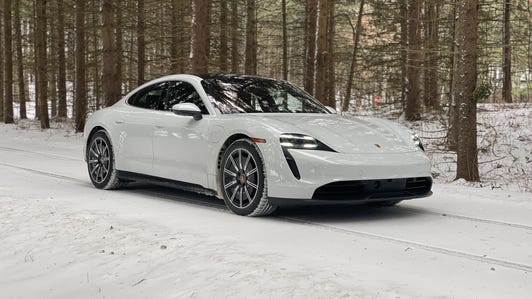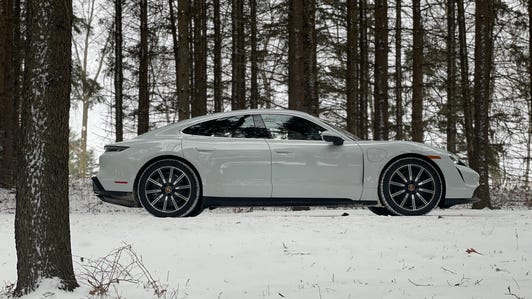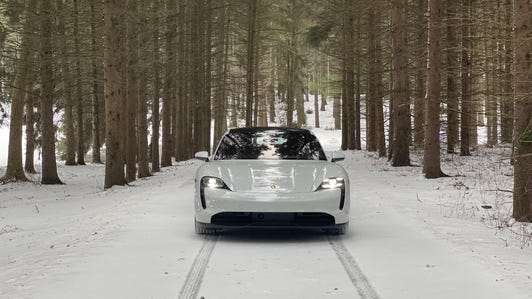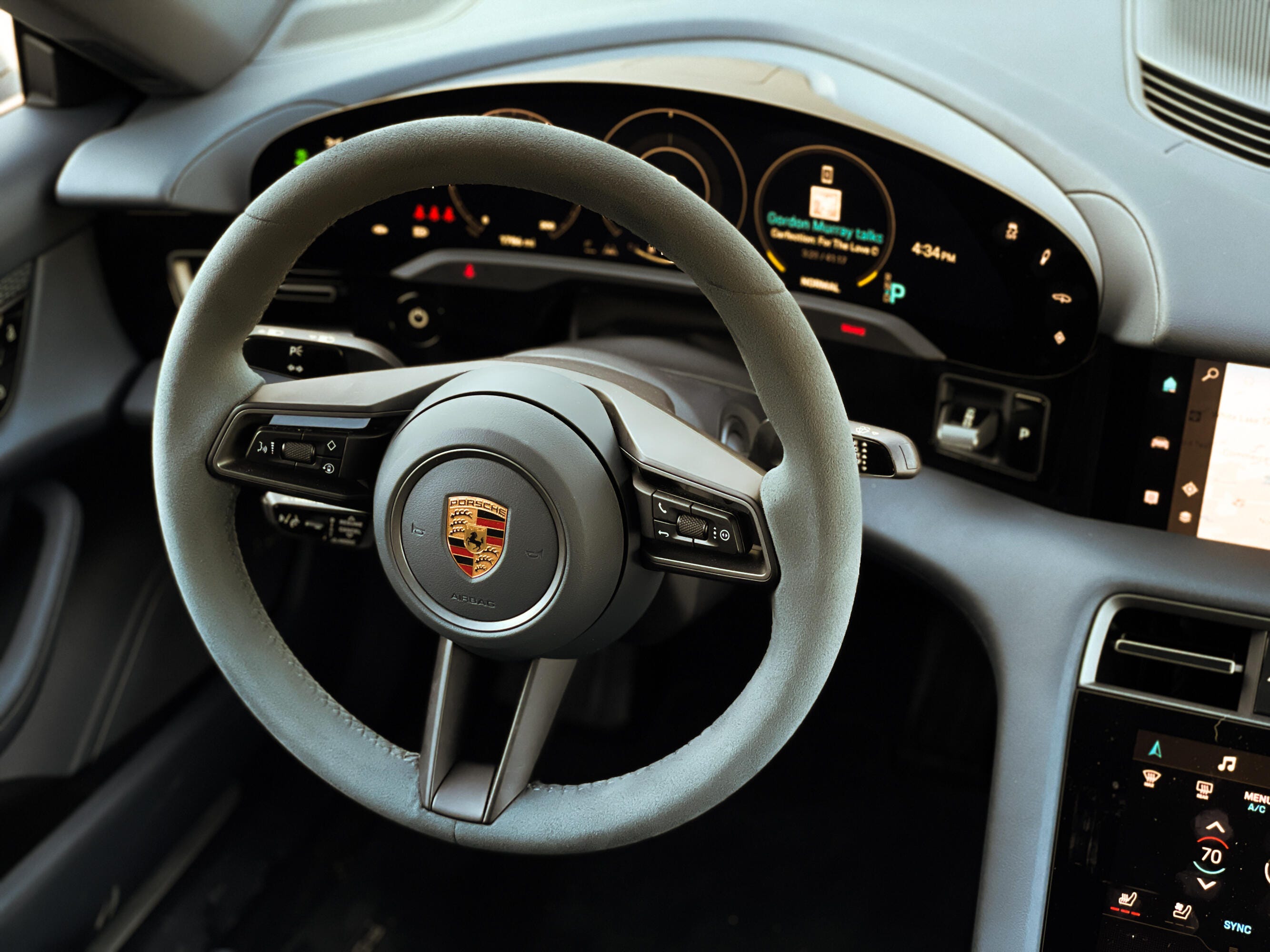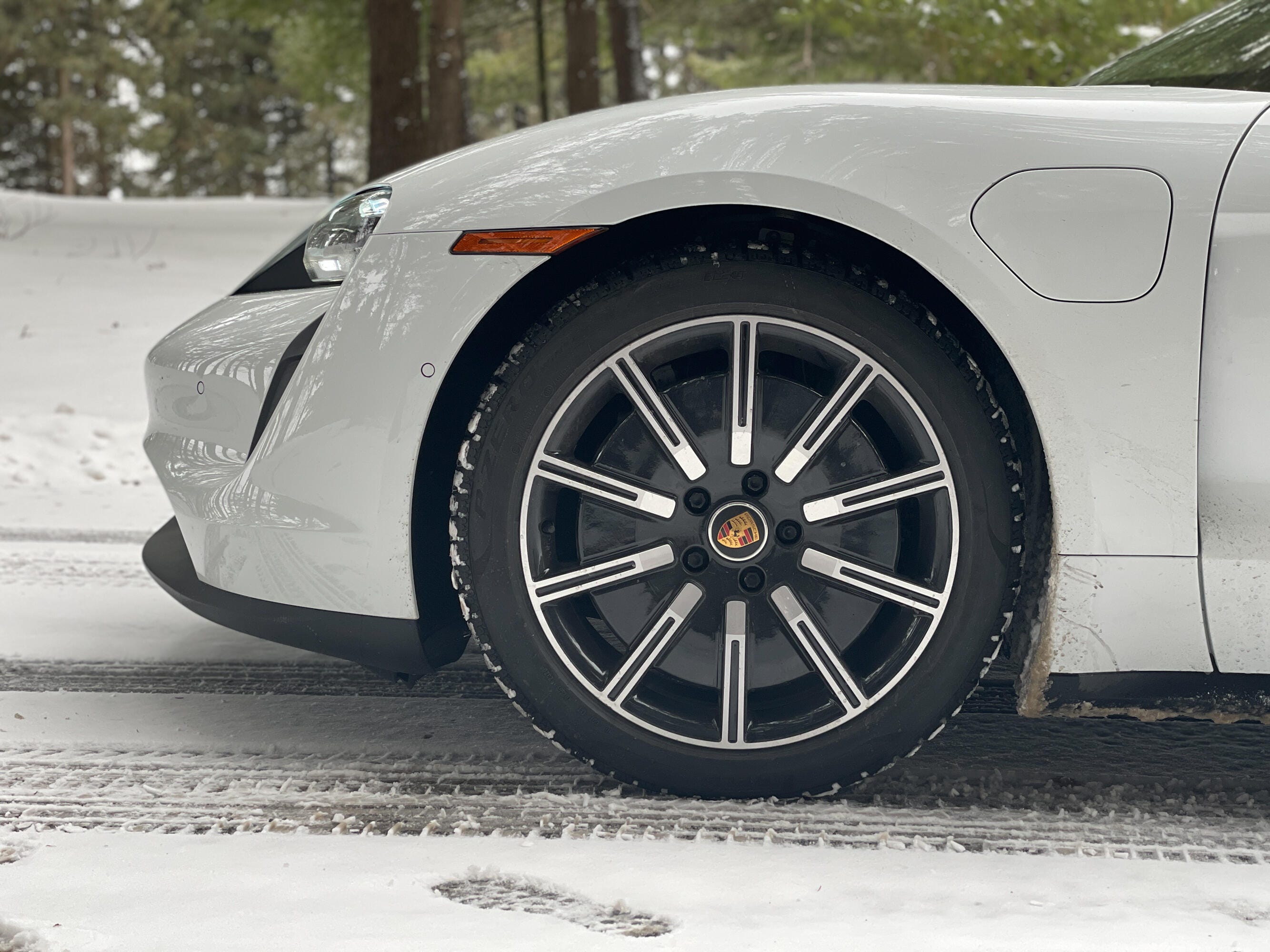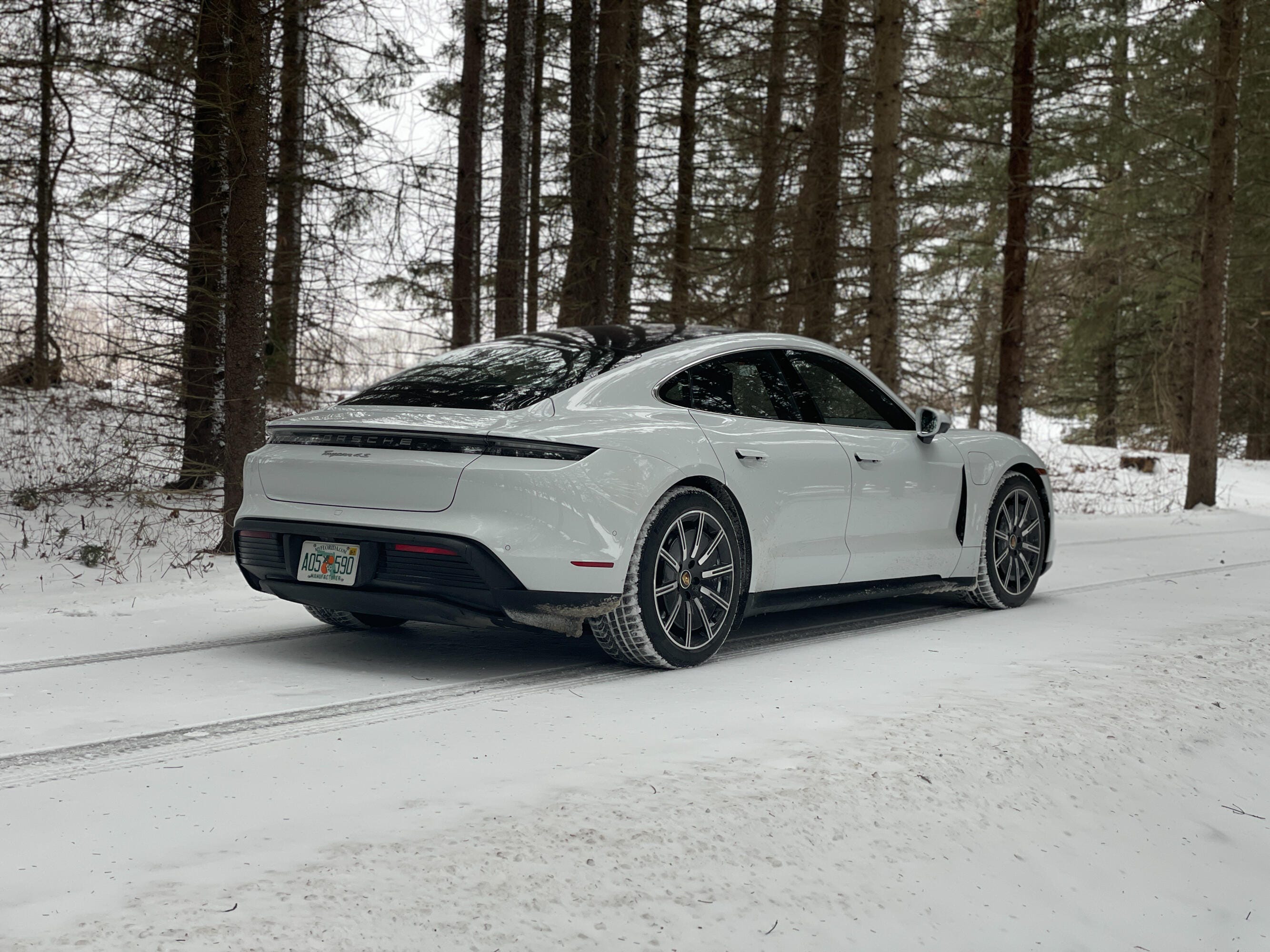
Crisp air, crisper performance.
Chris Paukert/RoadshowPorsche's Taycan EV is ostensibly a Tesla Model S rival -- arguably its most direct competitor. Indeed, the Taycan's all-electric powertrain, prodigious power and four-door design all appear to fall neatly into that mold. But if you're even passingly familiar with driving Elon Musk's Dream Machine, it's quite a surprise to drop all the way down into the bucket of the 2021 Porsche Taycan 4S. The German's low-slung seating position and view out over the windshield feel infinitely more sports carlike than the more traditional, sedanlike perch found in the Tesla.
Like
- Visceral, sports-car-like feel
- Effortless acceleration
- Endless personalization
Don't Like
- Limited range
- Pricy options
- No Android Auto
- No one-pedal drive mode
In fact, after a week behind the wheel of the Taycan, I'd go so far as to say that were today's EV market more mature and varied in its number of offerings, many people wouldn't be tempted to compare these two at all. The Porsche is a 911 that happens to be electric and have an extra set of doors, and the Tesla is arguably more of a sport sedan that happens to be electric (ironic, as the S is a hatchback and the Porsche is a sedan). That's not a knock on either automakers' approach to our electric future, as both are wonderfully accomplished machines, but despite these EVs both possessing ludicrous acceleration and handling, they feel totally distinct from each other and live different lives.
It's evident right from the get-go that Porsche has gone its own way with the Taycan. The whole car sits closer to the ground and its nose and tail are sleeker. As a result, this is a car that requires some practical concessions in return for its more sporting reflexes. I'm not just referring to the 4S' sports car numbers -- the model's 0-to-60-mph time is 3.8 seconds and its top speed is 155 mph, all of which is well within the bounds of what's possible from Team Musk.
The 4S is the 482-horsepower (562 hp with launch control) midgrade Taycan, sitting between the recently released 321-hp rear-drive base model and the teleportation-esque 616-hp Turbo. Offering 479 pound-feet of torque, the all-wheel-drive 4S relies on a smaller inverter with the same motor as the Turbo up front, as well as a smaller motor out back. Priced from $105,150 (including a $1,350 destination fee), the Taycan 4S may seem like a relative bargain compared with the $150,000 Turbo, but it's nevertheless eye-wateringly expensive. A drive in the 4S makes it easy to feel like this model is the Goldilocks of the Taycan family, but the truth is, it's a stunner from top to bottom, offering amazing all-around driving experiences that are typically coupled with wiltingly high price points.
The Porsche's difference is in its feel beyond its raw numbers. The 4S' handling sets it apart, with an immediacy to its steering and braking, paired with a well-sorted air suspension that is everyday-livable, yet capable of making the most out of every corner. It doesn't even take nine-tenths handling to figure out how special the 4S feels, which is a good thing, because as the photos accompanying this article suggest, the weather isn't always exactly cooperative. The multimode suspension is compliant enough for everyday comfort, enabling remarkably flat cornering even without selecting stiffer settings. PCCB carbon-ceramic brakes are available, but seem like costly overkill unless you plan to visit racetracks regularly.
Despite not having a hooded binnacle, those digital gauges are visible in all lights.
Chris Paukert/RoadshowThe Taycan's two-speed transmission continues to be something of a novelty in the EV world -- nearly every other production electric goes with a single-speed direct-drive. The Taycan's two-speed gearbox acts on the rear axle to provide both high-speed cruising efficiency and better low-end acceleration. While you probably won't even notice the transmission's operation in everyday driving, it is noticeable under hard acceleration. That's not a complaint -- it's actually nice to get a subtle thwack in the back as the transmission shifts gears, as it gives the Taycan a reassuringly mechanical quality, even if it doesn't presently make the 4S materially quicker than models from You Know Who.
Interestingly, you won't find a full-blown one-pedal driving mode in this Taycan, although you can adjust the amount of lift-off energy recuperation. Porsche says this approach affords more consistent braking feel regardless of the battery's state of charge, and indeed, the 4S offers the most natural modulation of any EV I've ever encountered. Having said all that, this driver would still prefer to have a one-pedal option.
The 4S' sports carlike demeanor extends to its driving range, which is just 227 miles according to the EPA -- and that's when equipped with the optional dual-layer 93.4-kilowatt-hour lithium-ion pouch Performance Battery Plus, a $6,580 option. The 79.2-kWh standard-battery model taps out at 199 miles, and both range totals are significant improvements over the figures promised for the 2020 model. Both are a pittance compared with what's available elsewhere, including the Model S Long Range Plus' EPA-estimated 402 miles.
In profile, the Taycan's 911-like design characteristics come through best.
Chris Paukert/RoadshowAs we at Roadshow and other outlets have told you in the past, not all range estimates work out the same in the real world, and we've found it's significantly easier to get (or beat) the stated range of Porsche's Taycan family in more situations than we have been able to in various Teslas. On the downside, Porsche nickels-and-dimes you for the best charging experience -- an onboard 150kW/400V DC charger is a $460 option and Mobile Charge Connect (a charge cord with a built-in 5-inch screen) is $1,120. Even Porsche Intelligent Range Manager, a software function that calculates charge stops based on available range and driving style, is a further $300.
Fortunately, even an early spring snow in Michigan didn't thwart my Carrara White Metallic 4S test car's range, or its driving fun. In the end, though, there's little doubt that there's a significant range deficit here, so this Stuttgart special may be best viewed as a Sunday fun-day indulgence or a daily commuter rather than as a viable interstate grand tourer.
As a consequence of its slightly more compact powertrain componentry, the 4S actually offers a bit more rear trunk space than the Turbo, but that's not to say that any Taycan offers a particularly generous amount of room. This 4S nets out at 17.2 cubic feet spread between its two cargo holds (14.3 cubes in back and 2.9 in the frunk). Compared with the Tesla, the Taycan is arguably best viewed here as an all-electric sports car with some additional spacial flexibility for two extra people in a pinch. (If you need more cargo room, Porsche now offers the Taycan in a fetching Sport Turismo bodystyle).
20-inch Sport Aero ($2,720) wheels thankfully arrived wrapped in Pirelli P-Zero winter rubber.
Chris Paukert/RoadshowIt isn't just the hunkered-down seats that ram home the Taycan's driving-first message, as the rest of the cabin follows suit. The dashboard is low-slung, with its prominent center stack contributing to a pronounced cockpitlike feel. The reconfigurable all-digital instrument panel is ultra-crisp and legible in any light, despite being hoodless. With tons of piano-black trim and plenty of touchscreen real estate, this particular 4S looks at once sleek and high-tech, but those same finishes make the cabin a fingerprint and dust magnet like few other test cars I can remember.
Speaking of high-tech, you can get the Taycan with up to five screens, including the aforementioned 16.8-inch gauge cluster. The central touchscreen measures 10.9 inches, plus there's an 8.4-inch HVAC touchscreen and an optional 5.9-inch passenger display (not fitted to this vehicle).
Like my fellow Roadshow compatriots, I've come to appreciate Porsche's latest-generation infotainment, though there is a learning curve and some will wish for more physical switchgear -- especially for easier manipulation of things like airflow, which is controlled entirely via menus instead of a more intuitive manual approach. If you're looking for the simplest solution, you can rely on Apple CarPlay for most functions, but Android Auto remains unavailable, at least until the 2022 model year, when Porsche will start filtering the tech into various models in its lineup.
Maybe just a few more miles...
Chris Paukert/RoadshowMy particular test car has comfortable, supportive 18-way power Adaptive Sport Seats ($400) clad in unusual Race-Tex fabric upholstery. With many high-end buyers seeking alternatives to traditional leather seats, this Graphite Blue material could be a welcome alternative, but I find it to be a bit coarse, both to the hand and, at $4,130, to the wallet. All-in, combined with other pricy options like 20-inch Sport Aero wheels ($2,770) and a $7,170 Premium Package (Bose audio, fixed glass roof, 360-degree camera coverage, ventilated seats and other niceties), this model rings up at $136,190 before available federal and state EV incentives. That's a lot of coin in options, but Porsche's build-it-your-way configurability is off the charts, and as such, $30,000 in options isn't an atypical amount for Porsche customers at this end of the spectrum.
In the end, even with four doors, the Taycan 4S absolutely feels like the Porsche sports car of the future. It offers rewardingly self-assured, tactile high performance in a unique formula at a very exclusive price. As the middle child of the most driver-focused EV family available today, the 4S is a formidable and downright lustworthy machine -- provided you're willing to look beyond its spec sheet and price tag.





























